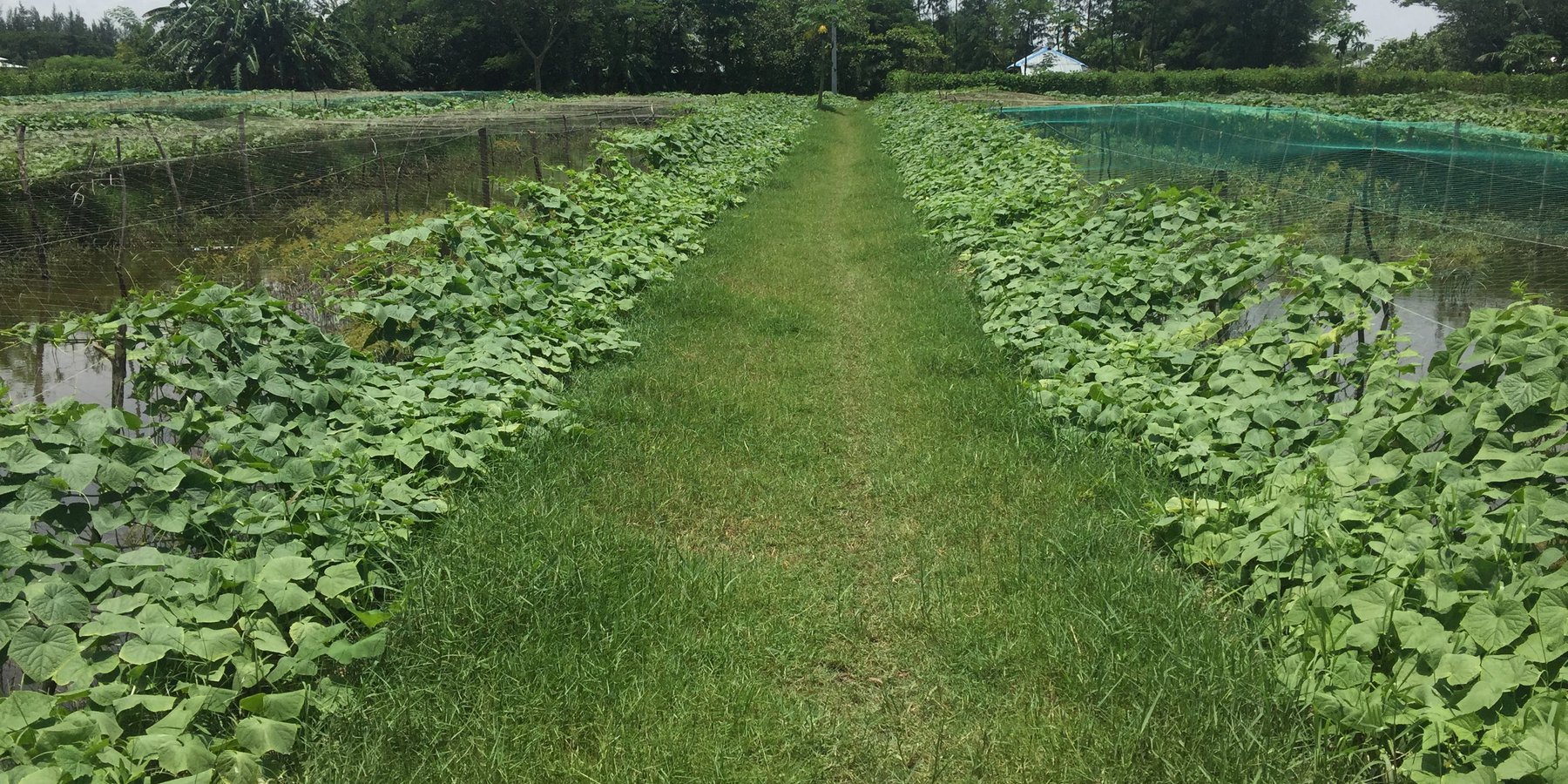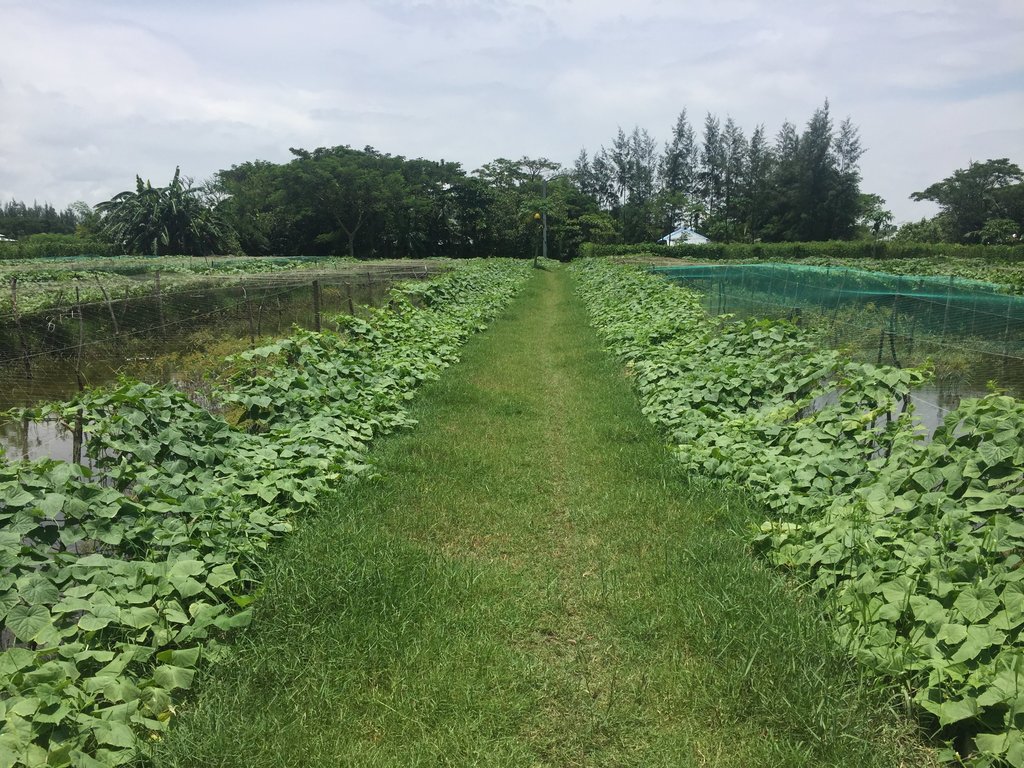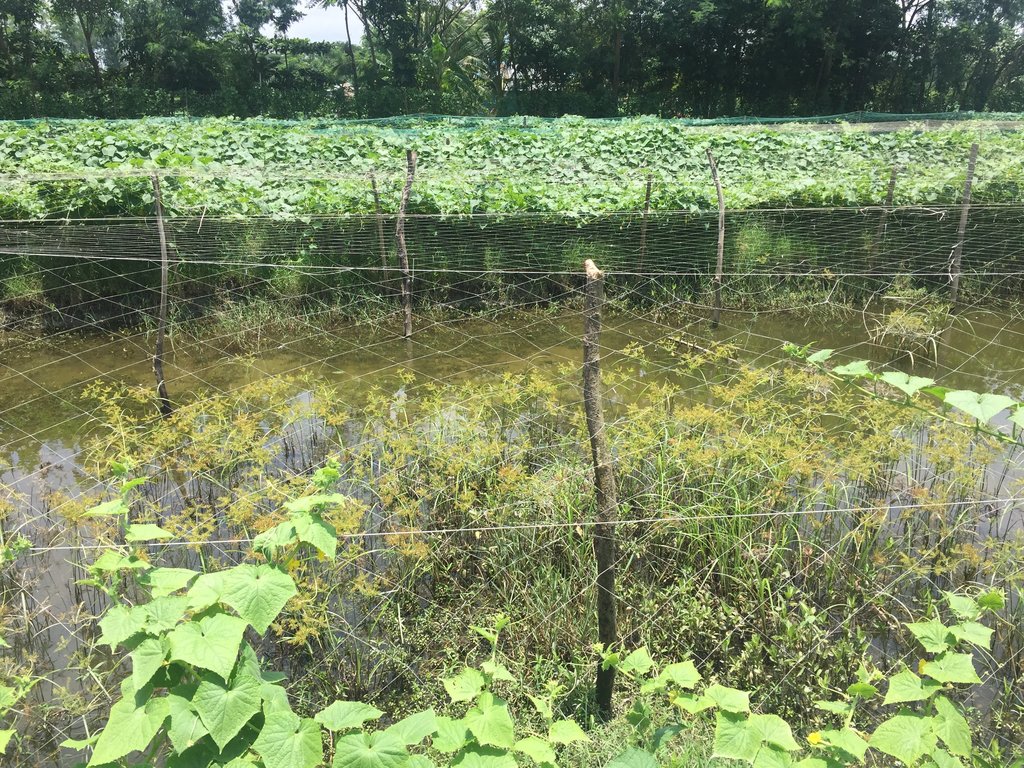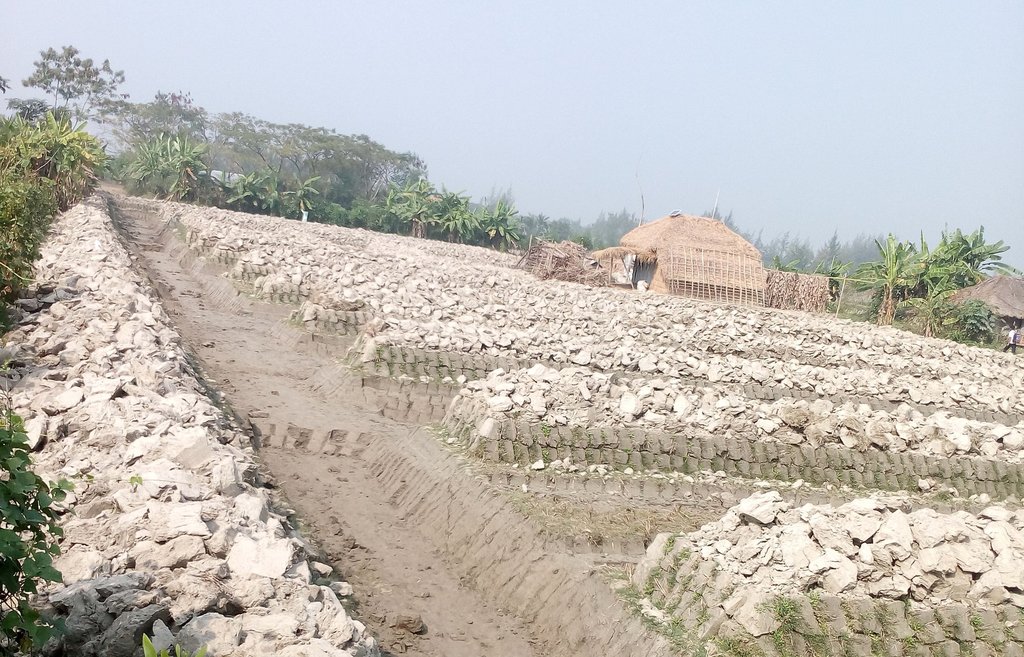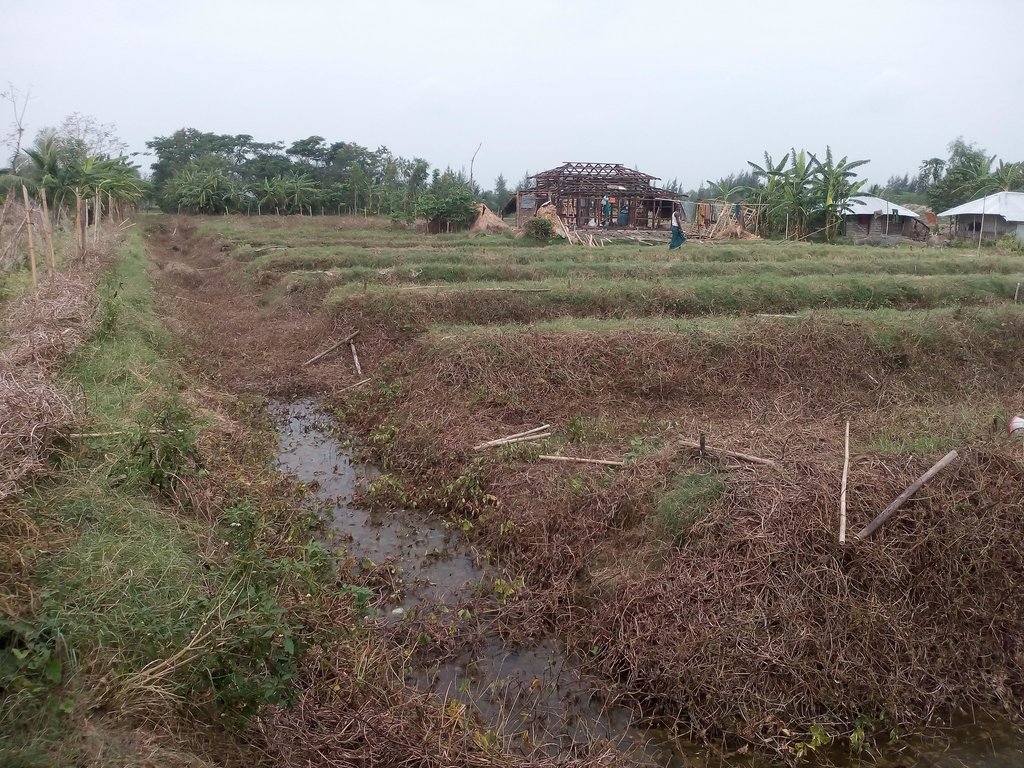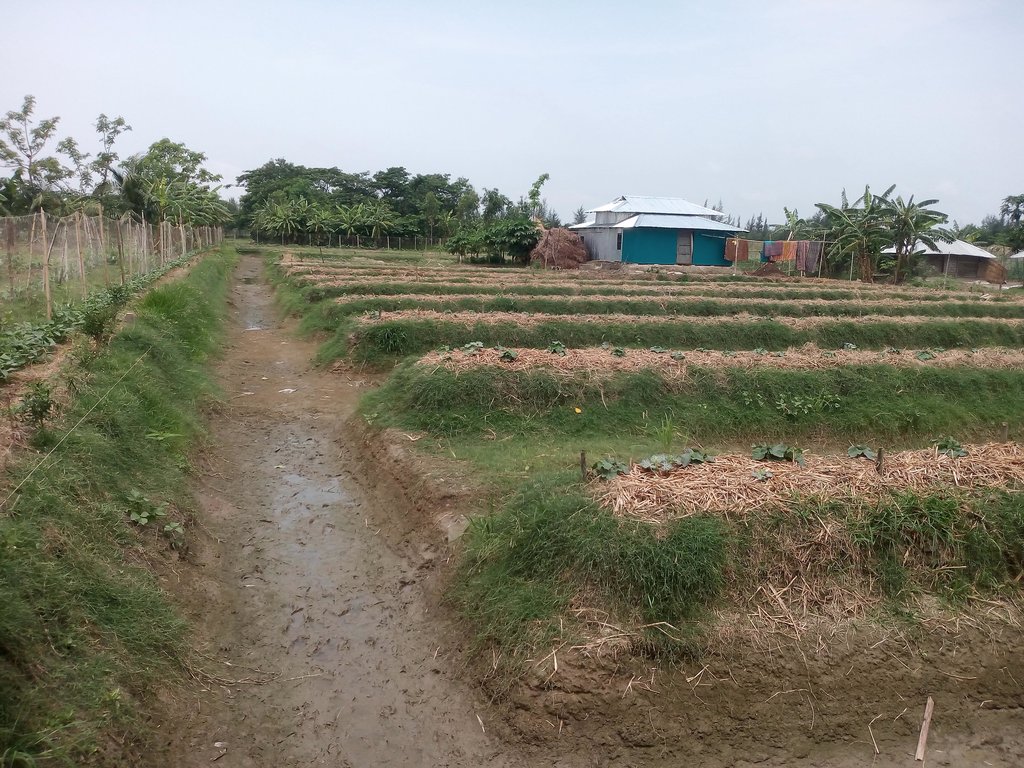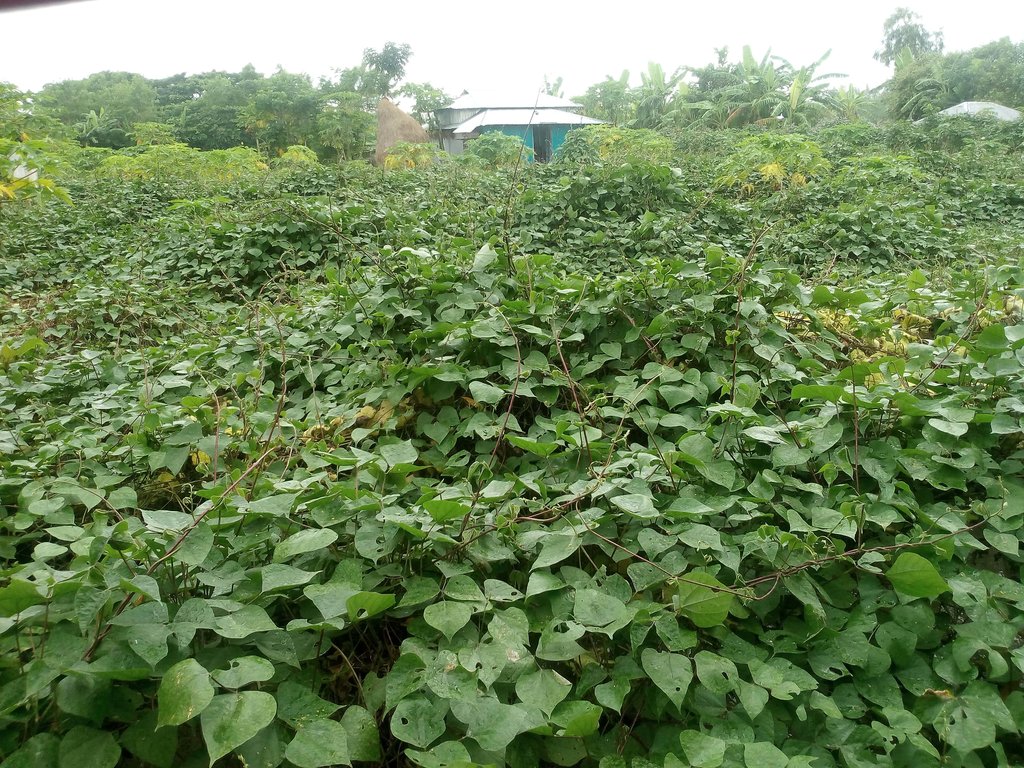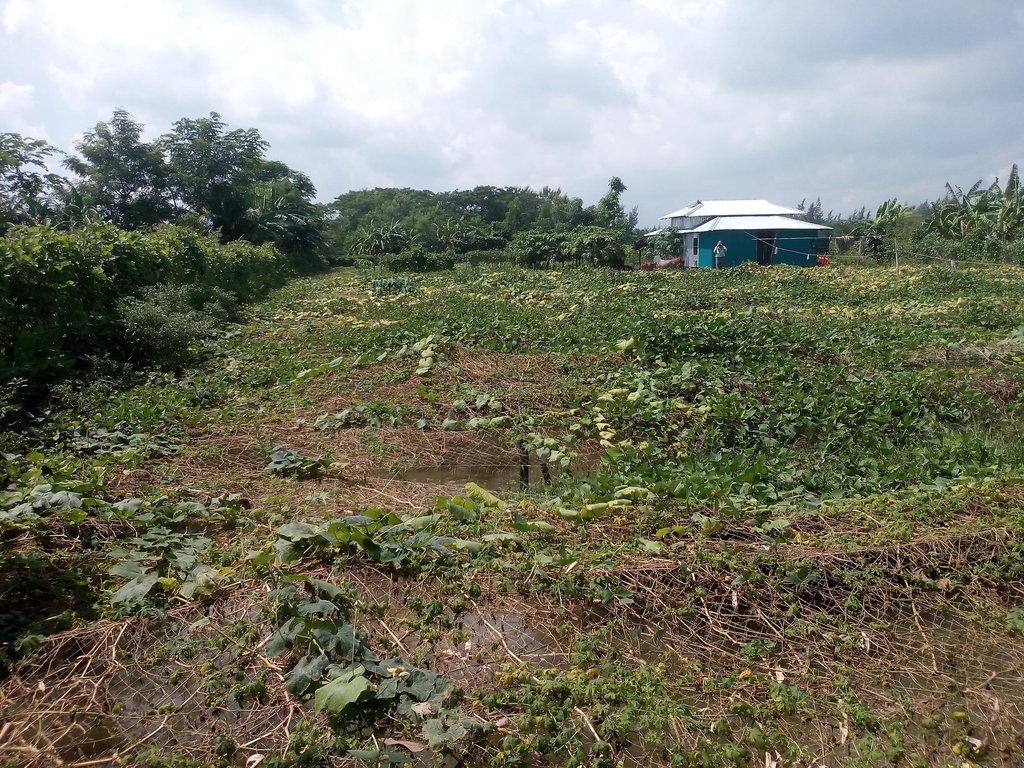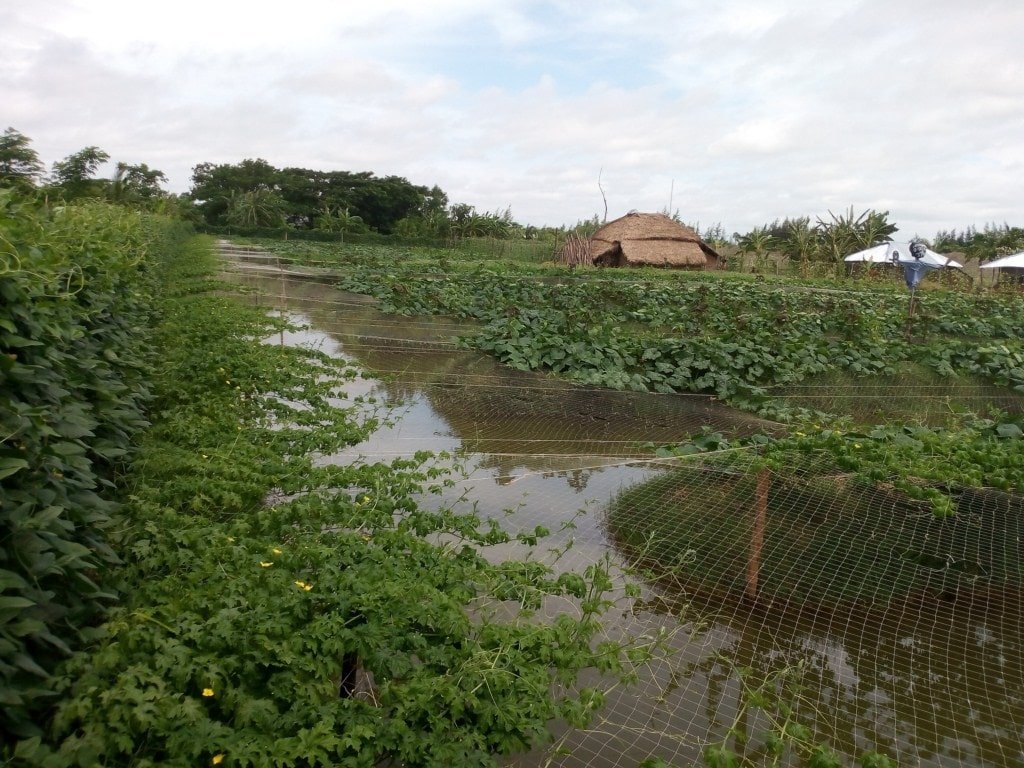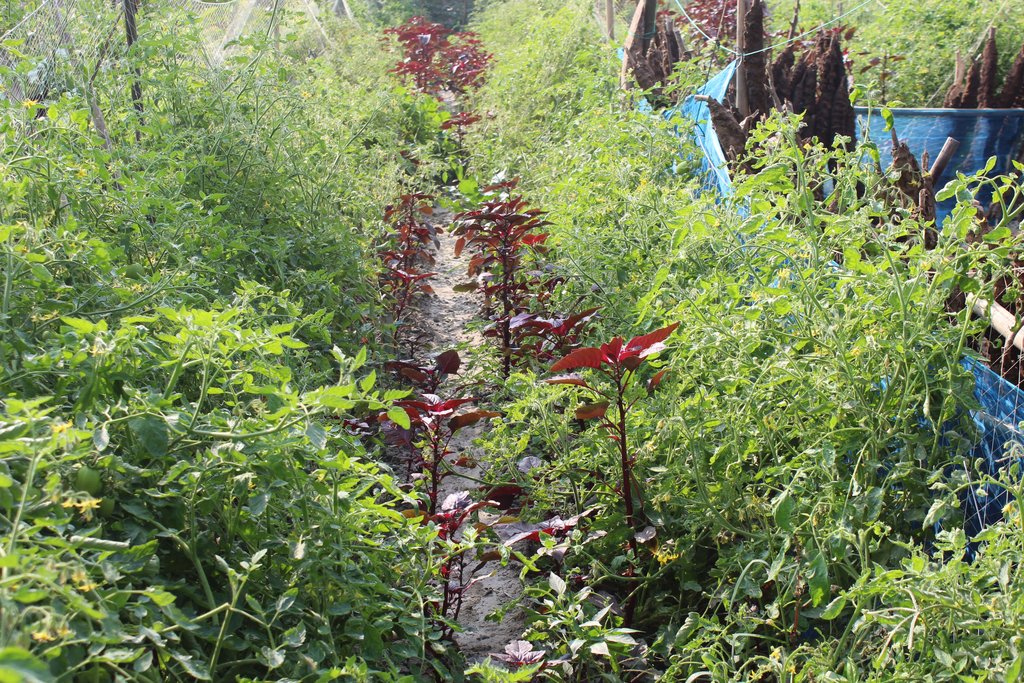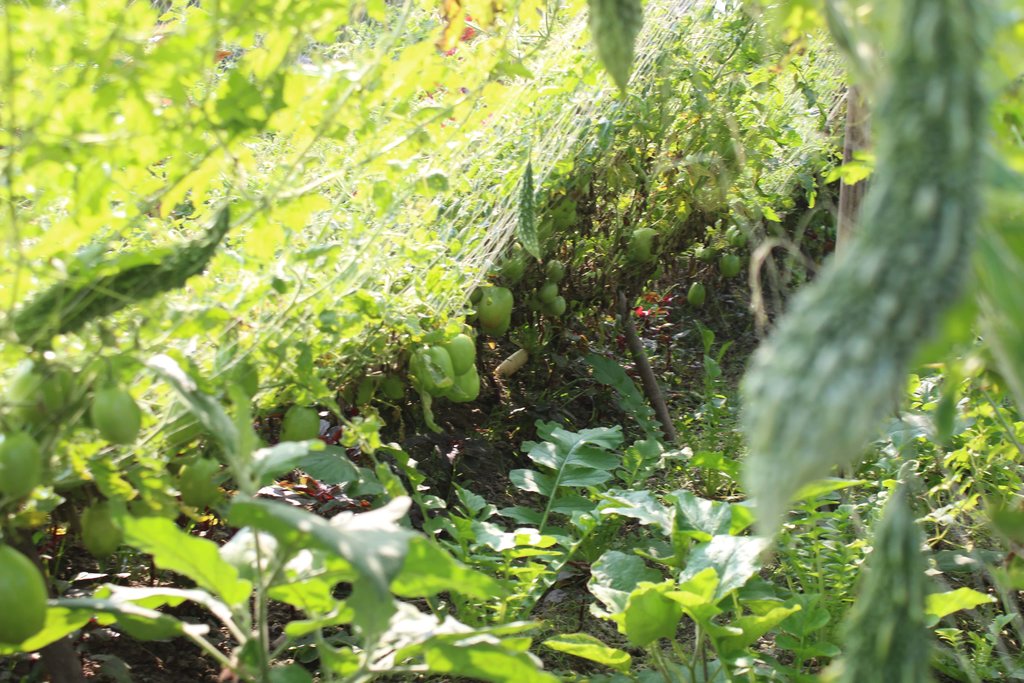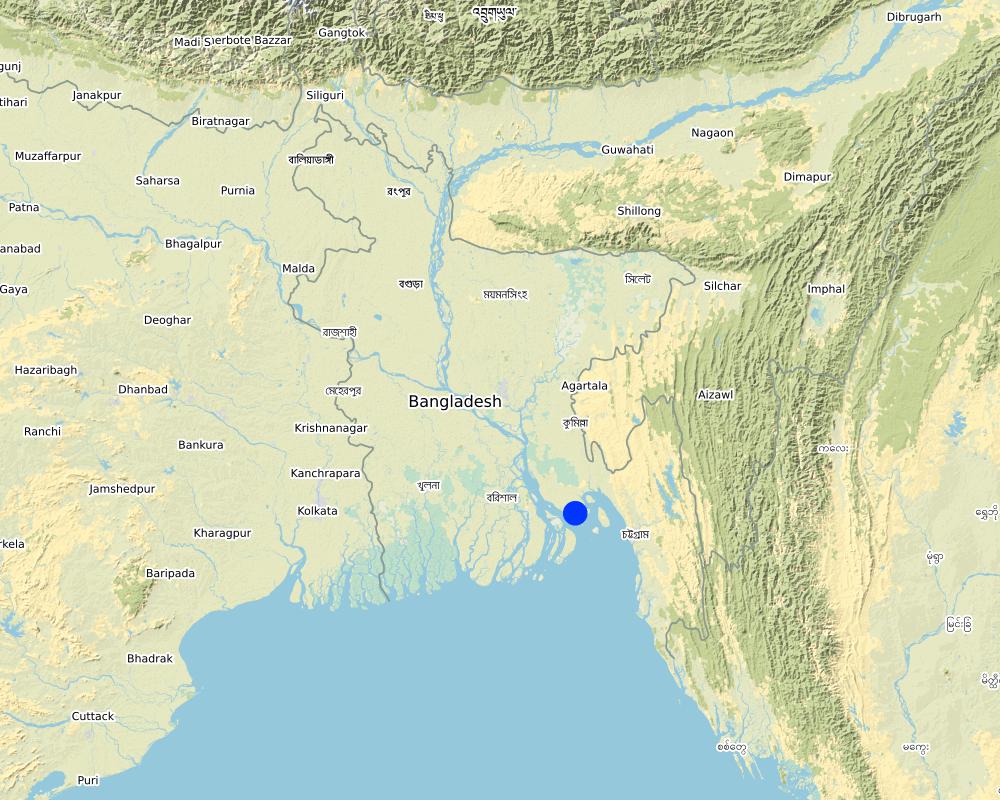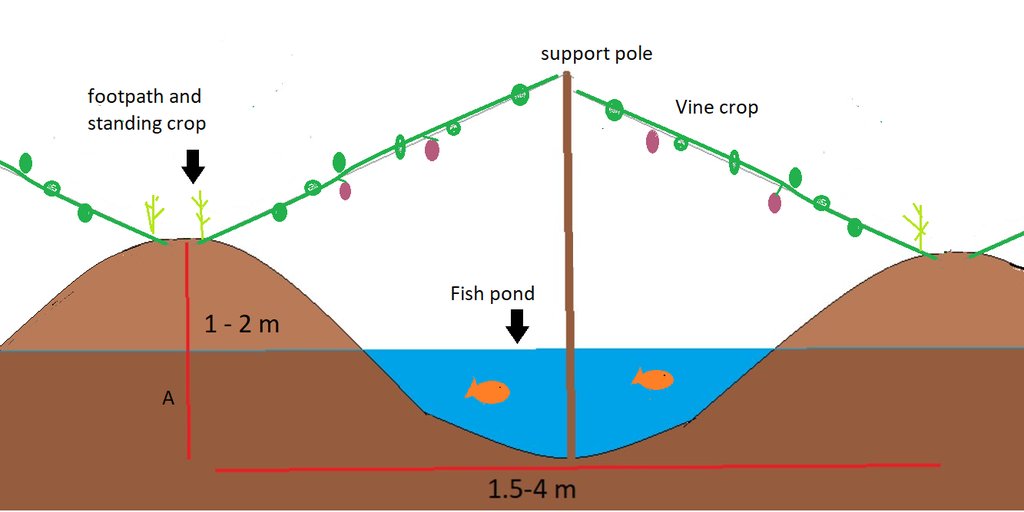Sorjan - growing vegetables on raised beds in waterlogged areas [Bangladesh]
- Création :
- Mise à jour :
- Compilateur : Wolfgang Duifhuizen
- Rédacteur : Kiran Sankar Sarker
- Examinateurs : Ursula Gaemperli, Rima Mekdaschi Studer
technologies_5613 - Bangladesh
Voir les sections
Développer tout Réduire tout1. Informations générales
1.2 Coordonnées des personnes-ressources et des institutions impliquées dans l'évaluation et la documentation de la Technologie
M&E adviser:
Nom du projet qui a facilité la documentation/ l'évaluation de la Technologie (si pertinent)
Char Development and Settlement Project- Bridging (CDSP)Nom du ou des institutions qui ont facilité la documentation/ l'évaluation de la Technologie (si pertinent)
International Fund for Agricultural Development (IFAD) - ItalieNom du ou des institutions qui ont facilité la documentation/ l'évaluation de la Technologie (si pertinent)
Embassy of the Kingdom of the Netherlands in Dhaka, Bangladesh (Dutch Embassy) - BangladeshNom du ou des institutions qui ont facilité la documentation/ l'évaluation de la Technologie (si pertinent)
Government of Bangladesh (Gov BDG) - Bangladesh1.3 Conditions relatives à l'utilisation par WOCAT des données documentées
Le compilateur et la(les) personne(s) ressource(s) acceptent les conditions relatives à l'utilisation par WOCAT des données documentées:
Oui
1.4 Déclaration sur la durabilité de la Technologie décrite
Est-ce que la Technologie décrite ici pose problème par rapport à la dégradation des terres, de telle sorte qu'elle ne peut pas être déclarée comme étant une technologie de gestion durable des terres?
Non
2. Description de la Technologie de GDT
2.1 Courte description de la Technologie
Définition de la Technologie:
The sorjon system is the cultivation of vegetables on raised beds. Ridges are about 60 to 90 cm high, which means crops are kept above the water, even during the wet season. The ditches between the ridges hold water for six to eight months per year and can be used to keep fish as well as being a source of water to irrigate the crops.
2.2 Description détaillée de la Technologie
Description:
The Sorjan is a system that serves as an alternate of deep drains (ditches) and raised beds for crop cultivation and fish rearing. In coastal Bangladesh the ridges are mostly around one meter wide at the top and spaced two meters apart – although in places ridges and spacing can be wider than this. The Sorjan system is applied in lowland areas which suffer from water logging and salinization. The widely spread technology is also practiced in Char Nangulia, Noakhali district in the Meghna estuary in Bangladesh. The main economic activities in this area are small-scale agriculture, livestock keeping, fish rearing and informal business. Before introduction of the Sorjan system (by the Bangladesh by Department of Agriculture Extension) only deep-water tolerant traditional low-yielding paddy could be cultivated during the rainy season and in the dry season, the capillary rise of salty ground water led to poor yields for most crops, if they survived at all.
The beds are about 60 to 90 cm high, which means crops are kept above the water, even during the wet season. The ditches between the ridges hold water for six to eight months per year and can be used to rear fish and ducks as well as being a source of water to irrigate the crops. In most cases nets are spanned over the ditches, allow climbing plants to grow over them utilizing the space in an efficient way. The sorjan system is is applied in low land areas and frequently suffer from water logging and sometimes salt water intrusion. This system with raised bed enables the cultivation of vegetables in these locations.
The main function of Sorjan is to grow crops on raised beds so that roots are protected against stagnant water. As the area is partially excavated, the deeper areas can be used for fish rearing whenever inundated and crops such as cucumber and gourds can grow vines on supporting nets spanned over the ditches to maximize productivity of limited space available. In the Philipines Sorjan system, it has also been reported that rice is cultivated in the ditches with shallow water and at the same time, other crops on the beds.
To install Sorjan a farmer needs to make raised beds for planting the crops and rear fish in the deep drains. This is usually done by hand with help of local laborers, in some cases an excavator is rented to do the job. To support the crop to be planted , a framework of bamboo, string and netting is built over the ditches to support a sequence of climbing plants.
Maintenance of the beds is done regularly whenever necessary and the crop netting is replaced every 3 years. In the area farmers predominantly use urea and other chemical fertilizers to lesser extent, few farmers use animal manure and compost. Most Sorjan ridges have a permanent undergrowth of grass to keep the slopes stable. In some cases, during dry season, goats graze the grass in the ditches and slopes.
Before the rains start in March, cucumbers are planted, and these are followed by a variety of gourds (including snake, bottle, bitter and ribbed gourds) in the early monsoon, with yard long bean (asparagus bean) and country bean (lablab bean) in the later monsoon, with country beans continuing to be harvested through the dry season up to the following March. During dry season the beans are sometimes intercropped with chillies, tomatoes and amaranth. These crops overlap with each other, with relay cropping allowing continuous harvesting for 9 or 10 months per year (early June to March).
The significant increase of income a small-holder farmer can make in the area alongside having fresh fish and vegetable for the greater part of the year have been reasons for farmers taking up Sorjan. The Sorjan system is propagated as a measure to mitigate effects of increased salinity and/or water logging due to sea-level rise. Sorjan does not facilitate any mechanization as the narrow beds and ditch bottoms are only accessible by foot.
2.3 Photos de la Technologie
Remarques générales concernant les photos:
The pictures of Sorjan at homestead in Nangulia are all taken from the same point at different times: 1. establishment of Sorjan 2. and 3. Sorjan with rabi crop in winter time 4. country bean in winter time 5 and 6. gourd crop in summer time
2.5 Pays/ région/ lieux où la Technologie a été appliquée et qui sont couverts par cette évaluation
Pays:
Bangladesh
Région/ Etat/ Province:
Chittagong Division, Noakhali District
Autres spécifications du lieu:
Char Nangulia
Spécifiez la diffusion de la Technologie:
- appliquée en des points spécifiques ou concentrée sur une petite surface
Est-ce que les sites dans lesquels la Technologie est appliquée sont situés dans des zones protégées en permanence?
Non
Commentaires:
Also applied elsewhere in Bangladesh, the Philipines and Indonesia.
Map
×2.6 Date de mise en œuvre de la Technologie
Si l'année précise est inconnue, indiquez la date approximative: :
- il y a moins de 10 ans (récemment)
2.7 Introduction de la Technologie
Spécifiez comment la Technologie a été introduite: :
- au cours d'expérimentations / de recherches
- par le biais de projets/ d'interventions extérieures
Commentaires (type de projet, etc.) :
Introduced to Bangladesh by Department of Agriculture Extension and originated in Indonesia.
3. Classification de la Technologie de GDT
3.1 Principal(aux) objectif(s) de la Technologie
- améliorer la production
- s'adapter au changement et aux extrêmes climatiques et à leurs impacts
- atténuer le changement climatique et ses impacts
- créer un impact économique positif
- créer un impact social positif
3.2 Type(s) actuel(s) d'utilisation des terres, là où la Technologie est appliquée
Les divers types d'utilisation des terres au sein du même unité de terrain: :
Non

Terres cultivées
- Cultures annuelles
Cultures annuelles - Précisez les cultures:
- céréales - riz (de terres humides)
- légumineuses et légumes secs - fèves
- légumineuses et légumes secs - soja
- cultures oléagineuses - tournesol, colza, autres
Nombre de période de croissance par an: :
- 2
Précisez:
In case of saline groundwater only one paddy crop can be grown in monsoon season
Est-ce que les cultures intercalaires sont pratiquées?
Non

Terres improductives
Remarques:
The farmers invest their capital in making land productive by establishing Sorjan or other measures to enable crop cultivian in areas with severe waterlogging
3.3 Est-ce que l’utilisation des terres a changé en raison de la mise en œuvre de la Technologie ?
Est-ce que l’utilisation des terres a changé en raison de la mise en œuvre de la Technologie ?
- Non (Passez à la question 3.4)
3.4 Approvisionnement en eau
Approvisionnement en eau des terres sur lesquelles est appliquée la Technologie:
- mixte: pluvial-irrigué
Commentaires:
Thesystem is rainfed during the monsoon season (June-October); by storage of water around ridges this water supply will last until January. When planting crop in march water from deep tube wells is used.
3.5 Groupe de GDT auquel appartient la Technologie
- système de rotation (rotation des cultures, jachères, agriculture itinérante)
- Amélioration de la couverture végétale/ du sol
- gestion/ protection des zones humides
3.6 Mesures de GDT constituant la Technologie

pratiques agronomiques
- A1: Couverture végétale/ du sol

structures physiques
- S4: Fossés isohypses, trous
- S5: Barrages/retenues, micro-bassins, étangs
3.7 Principaux types de dégradation des terres traités par la Technologie

dégradation chimique des sols
- Cs: salinisation/ alcalinisation

dégradation physique des sols
- Pw: saturation en eau des sols
Commentaires:
Local conditions make crop cultivation difficult due to poor drainage (water logging) in rainy season and capillary rise of sea water in dry season.
3.8 Prévention, réduction de la dégradation ou réhabilitation des terres dégradées
Spécifiez l'objectif de la Technologie au regard de la dégradation des terres:
- s'adapter à la dégradation des terres
Commentaires:
by growing vegetables on raised beds the crops suffer less from capillary rise of sea water in dry-season and water logging in rainy season.
4. Spécifications techniques, activités, intrants et coûts de mise en œuvre
4.1 Dessin technique de la Technologie
Spécifications techniques (associées au dessin technique):
Sorjan ridges are usually between 1 to 2 meters in height and have a spacing between 2 to 5 meters. Ridges are usually covered with grass on the sides and straw mulch on the top. The ridge-top has a footpath with crops planted along both sides (standing crop: chillies, amaranth etc.). Vine crops grow (beans, gourds, etc.) onto the netting supported by a pole of 2-3 m high. Fruits or pods are harvested while standing in the pond.
4.2 Informations générales sur le calcul des intrants et des coûts
Spécifiez la manière dont les coûts et les intrants ont été calculés:
- par superficie de la Technologie
Indiquez la taille et l'unité de surface:
acre
Si vous utilisez une unité de superficie locale, indiquez le facteur de conversion vers un hectare (p.ex. 1 ha = 2.47 acres): 1 ha = :
1 acre = 0.4 ha
autre/ monnaie nationale (précisez):
BDT
Indiquez le taux de change des USD en devise locale, le cas échéant (p.ex. 1 USD = 79.9 réal brésilien): 1 USD = :
85,0
Indiquez le coût salarial moyen de la main d'œuvre par jour:
100-200 BDT
4.3 Activités de mise en place/ d'établissement
| Activité | Calendrier des activités (saisonnier) | |
|---|---|---|
| 1. | digging ditches/sorjan | dry season |
| 2. | putting up bamboo and netting | after earthwork is done |
4.4 Coûts et intrants nécessaires à la mise en place
| Spécifiez les intrants | Unité | Quantité | Coûts par unité | Coût total par intrant | % du coût supporté par les exploitants des terres | |
|---|---|---|---|---|---|---|
| Main d'œuvre | excavation, bed construction and suspending of nets | person-days | 40,0 | 200,0 | 8000,0 | 100,0 |
| Equipements | shovels, baskets and other equipment | lump sum | 2000,0 | 100,0 | ||
| Matériaux de construction | poles + netting | lump sum | 1,0 | 30000,0 | 30000,0 | |
| Coût total de mise en place de la Technologie | 38000,0 | |||||
| Coût total de mise en place de la Technologie en dollars américains (USD) | 447,06 | |||||
Commentaires:
Excavation is often done with help of day labourers. Costs reduce if excavation can be done by excavator.
4.5 Activités d'entretien/ récurrentes
| Activité | Calendrier/ fréquence | |
|---|---|---|
| 1. | repair of ridges | annual |
| 2. | replace bamboo and netting | every third year |
| 3. | fertilizer | several times every growing season |
| 4. | planting/sowing crops | several times a year |
| 5. | mulching | annual |
| 6. | fish fry | annual |
Commentaires:
Maintenance activities are highly specific to situation and crop.
4.6 Coûts et intrants nécessaires aux activités d'entretien/ récurrentes (par an)
| Spécifiez les intrants | Unité | Quantité | Coûts par unité | Coût total par intrant | % du coût supporté par les exploitants des terres | |
|---|---|---|---|---|---|---|
| Main d'œuvre | repair of beds | |||||
| Main d'œuvre | replacement of netting structure | |||||
| Matériel végétal | Inputs production (seeds crops, fertilizers and fish feed) | |||||
| Autre | fish fry |
Si vous n'êtes pas en mesure de décomposer les coûts dans le tableau précédent, donnez une estimation du coût total de l'entretien de la Technologie:
400,0
Commentaires:
Costs of maintenance are highly variable depending on crop type and management. In most cases external labour is only required for establishment of Sorjan. The quanity of mulch spread on the beds is dependent on what material is available at farm-level.
4.7 Facteurs les plus importants affectant les coûts
Décrivez les facteurs les plus importants affectant les coûts :
Number of labour-days required to establish and repair earthworks and netting structure
5. Environnement naturel et humain
5.1 Climat
Précipitations annuelles
- < 250 mm
- 251-500 mm
- 501-750 mm
- 751-1000 mm
- 1001-1500 mm
- 1501-2000 mm
- 2001-3000 mm
- 3001-4000 mm
- > 4000 mm
Spécifiez la pluviométrie moyenne annuelle (si connue), en mm:
2980,00
Spécifications/ commentaires sur les précipitations:
monsoon climate; 70% of precipitation occurs during 4 months (July-September)
Indiquez le nom de la station météorologique de référence considérée:
Noakhali
Zone agro-climatique
- humide
5.2 Topographie
Pentes moyennes:
- plat (0-2 %)
- faible (3-5%)
- modéré (6-10%)
- onduleux (11-15%)
- vallonné (16-30%)
- raide (31-60%)
- très raide (>60%)
Reliefs:
- plateaux/ plaines
- crêtes
- flancs/ pentes de montagne
- flancs/ pentes de colline
- piémonts/ glacis (bas de pente)
- fonds de vallée/bas-fonds
Zones altitudinales:
- 0-100 m
- 101-500 m
- 501-1000 m
- 1001-1500 m
- 1501-2000 m
- 2001-2500 m
- 2501-3000 m
- 3001-4000 m
- > 4000 m
Indiquez si la Technologie est spécifiquement appliquée dans des:
- non pertinent
Commentaires et précisions supplémentaires sur la topographie:
Reclaimed lands in estuarine area
5.3 Sols
Profondeur moyenne du sol:
- très superficiel (0-20 cm)
- superficiel (21-50 cm)
- modérément profond (51-80 cm)
- profond (81-120 cm)
- très profond (>120 cm)
Texture du sol (de la couche arable):
- moyen (limoneux)
Texture du sol (> 20 cm sous la surface):
- moyen (limoneux)
Matière organique de la couche arable:
- moyen (1-3%)
- faible (<1%)
5.4 Disponibilité et qualité de l'eau
Profondeur estimée de l’eau dans le sol:
< 5 m
Disponibilité de l’eau de surface:
excès
Qualité de l’eau (non traitée):
eau inutilisable
La qualité de l'eau fait référence à:
eaux souterraines
La salinité de l'eau est-elle un problème? :
Oui
Précisez:
In dry season the root zone is exposed to capillary rise of saline ground water
La zone est-elle inondée?
Oui
Régularité:
épisodiquement
Commentaires et précisions supplémentaires sur la qualité et la quantité d'eau:
In monsoon season there are frequent problems with waterlogging. In dry season the fresh water lens evaporates and saline ground water is to be found 2-5 meters below ground.
5.5 Biodiversité
Diversité des espèces:
- moyenne
Diversité des habitats:
- moyenne
5.6 Caractéristiques des exploitants des terres appliquant la Technologie
Sédentaire ou nomade:
- Sédentaire
Orientation du système de production:
- exploitation mixte (de subsistance/ commerciale)
Revenus hors exploitation:
- > 50% de tous les revenus
Niveau relatif de richesse:
- pauvre
Individus ou groupes:
- individu/ ménage
Niveau de mécanisation:
- travail manuel
- traction animale
Genre:
- femmes
- hommes
Age des exploitants des terres:
- personnes d'âge moyen
5.7 Superficie moyenne des terres utilisées par les exploitants des terres appliquant la Technologie
- < 0,5 ha
- 0,5-1 ha
- 1-2 ha
- 2-5 ha
- 5-15 ha
- 15-50 ha
- 50-100 ha
- 100-500 ha
- 500-1 000 ha
- 1 000-10 000 ha
- > 10 000 ha
Cette superficie est-elle considérée comme de petite, moyenne ou grande dimension (en se référant au contexte local)?
- petite dimension
5.8 Propriété foncière, droits d’utilisation des terres et de l'eau
Propriété foncière:
- individu, sans titre de propriété
- individu, avec titre de propriété
Droits d’utilisation des terres:
- individuel
- occupied
Droits d’utilisation de l’eau:
- communautaire (organisé)
Est-ce que les droits d'utilisation des terres sont fondés sur un système juridique traditionnel?
Non
Précisez:
Though government project (Char Development and Settlement Project) many settlers have obtained land rights to small pieces of land
5.9 Accès aux services et aux infrastructures
santé:
- pauvre
- modéré
- bonne
éducation:
- pauvre
- modéré
- bonne
assistance technique:
- pauvre
- modéré
- bonne
emploi (par ex. hors exploitation):
- pauvre
- modéré
- bonne
marchés:
- pauvre
- modéré
- bonne
énergie:
- pauvre
- modéré
- bonne
routes et transports:
- pauvre
- modéré
- bonne
eau potable et assainissement:
- pauvre
- modéré
- bonne
services financiers:
- pauvre
- modéré
- bonne
Commentaires:
Areas which received support of the Char Development and Settlement Project have much better access to infrastructure and services.
6. Impacts et conclusions
6.1 Impacts sur site que la Technologie a montrés
Impacts socio-économiques
Production
production agricole
Commentaires/ spécifiez:
single annual low-yield rice crop (< 1 t/ha) to year-round vegetables
production animale
Commentaires/ spécifiez:
fish rearing activities in areas previously used for paddy only
risque d'échec de la production
Commentaires/ spécifiez:
reduced risk of crop losses due to flooding or salinity
diversité des produits
Commentaires/ spécifiez:
single annual rice crop to year-round various vegetables
surface de production
Commentaires/ spécifiez:
Measure does not increase production area, but does allow more than 1 cropping season per year.
Revenus et coûts
diversité des sources de revenus
Commentaires/ spécifiez:
higher diversity of income sources: vegetables, fish etcetera.
Impacts socioculturels
sécurité alimentaire/ autosuffisance
Commentaires/ spécifiez:
Farmers using Sorjan report to cultivate more cash crops than before and are no longer dependent on food purchase for vegetables
Impacts écologiques
Sols
couverture du sol
Commentaires/ spécifiez:
Fallow period has become shorter by (almost) continuous cropping
salinité
Commentaires/ spécifiez:
No decrease of overall salinity, but effect on crop has shown to decrease
matière organique du sol/ au dessous du sol C
Commentaires/ spécifiez:
continuous crop cover is likely increase soil organic matter
Biodiversité: végétale, animale
diversité végétale
Commentaires/ spécifiez:
increased diversity of crops cultivated in area
diversité des habitats
Commentaires/ spécifiez:
from plane field to alternated high ridges and low wet areas.
6.3 Exposition et sensibilité de la Technologie aux changements progressifs et aux évènements extrêmes/catastrophes liés au climat (telles que perçues par les exploitants des terres)
Extrêmes climatiques (catastrophes)
Catastrophes météorologiques
| Comment la Technologie fait-elle face à cela? | |
|---|---|
| cyclone extratropical | bien |
Catastrophes climatiques
| Comment la Technologie fait-elle face à cela? | |
|---|---|
| sécheresse | modérément |
Autres conséquences liées au climat
Autres conséquences liées au climat
| Comment la Technologie fait-elle face à cela? | |
|---|---|
| élévation du niveau de la mer | bien |
6.4 Analyse coûts-bénéfices
Quels sont les bénéfices comparativement aux coûts de mise en place (du point de vue des exploitants des terres)?
Rentabilité à court terme:
positive
Rentabilité à long terme:
très positive
Quels sont les bénéfices comparativement aux coûts d'entretien récurrents (du point de vue des exploitants des terres)?
Rentabilité à court terme:
positive
Rentabilité à long terme:
très positive
6.5 Adoption de la Technologie
- 11-50%
Si disponible, quantifiez (nombre de ménages et/ou superficie couverte):
11% of farming households
De tous ceux qui ont adopté la Technologie, combien d'entre eux l'ont fait spontanément, à savoir sans recevoir aucune incitation matérielle, ou aucune rémunération? :
- 91-100%
6.6 Adaptation
La Technologie a-t-elle été récemment modifiée pour s'adapter à l'évolution des conditions?
Non
6.7 Points forts/ avantages/ possibilités de la Technologie
| Points forts/ avantages/ possibilités du point de vue de l'exploitant des terres |
|---|
| Land user's view is congruent with the key resource person's view. |
| Points forts/ avantages/ possibilités du point de vue du compilateur ou d'une autre personne ressource clé |
|---|
| Allows for a more diverse source of income for farmers, as instead of just 1-2 low-yielding crops per year as in Sorjan the same area becomes suitable to grow vegetables almost continuously and rear fish. |
| Increase of food security due to a higher diversity of locally-grown food crops. |
| Higher farm-income per land area unit with Sorjan than with traditional paddy field. |
6.8 Faiblesses/ inconvénients/ risques de la Technologie et moyens de les surmonter
| Faiblesses/ inconvénients/ risques du point de vue de l’exploitant des terres | Comment peuvent-ils être surmontés? |
|---|---|
| Land user's view is congruent with the key resource person's view. |
| Faiblesses/ inconvénients/ risques du point de vue du compilateur ou d'une autre personne ressource clé | Comment peuvent-ils être surmontés? |
|---|---|
| Sorjan does not allow mechanized farming. | Apply farm management which does not require machienery usage. |
7. Références et liens
7.1 Méthodes/ sources d'information
- visites de terrain, enquêtes sur le terrain
Case studies done under TR 25 'Agricultural developments'. These list effects of project interventions to farmers.
- compilation à partir de rapports et d'autres documents existants
Commentaires:
mostly based on reports retrieved at https://cdsp.org.bd/cdsp-iv-reports/
Technical report 20 and 25
7.3 Liens vers les informations pertinentes en ligne
Titre/ description:
CDSP IV reports
URL:
https://cdsp.org.bd/cdsp-iv-reports/
Liens et modules
Développer tout Réduire toutLiens
Aucun lien
Modules
Aucun module trouvé


